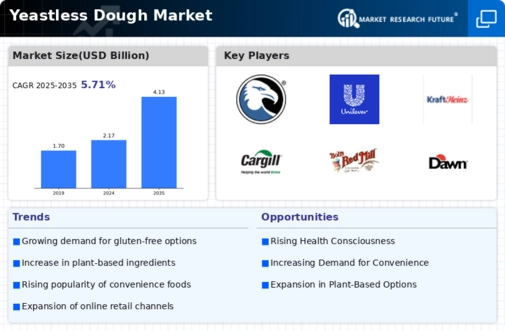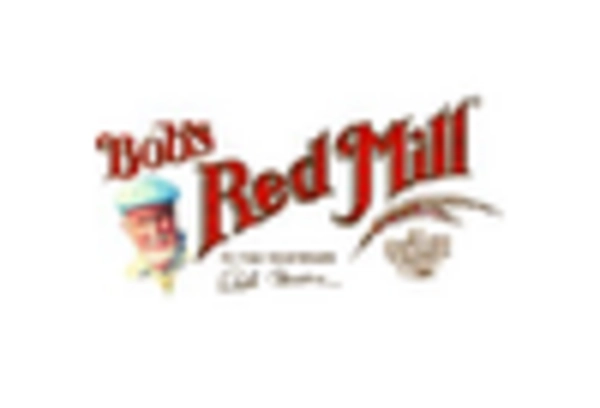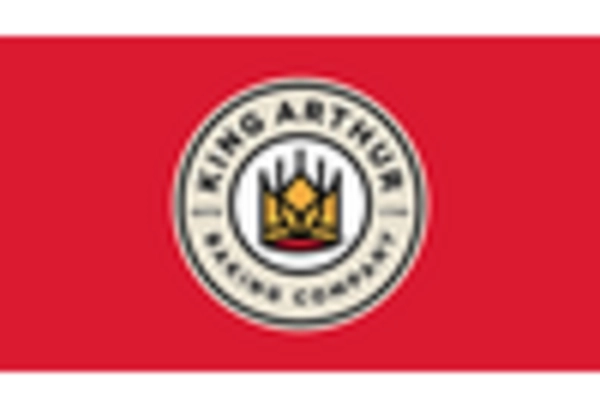Gluten-Free Demand
The Yeastless Dough Market is significantly influenced by the rising demand for gluten-free products. As awareness of gluten intolerance and celiac disease increases, consumers are actively seeking alternatives that do not contain gluten. Yeastless dough, often made from gluten-free flours such as almond or coconut, provides a viable solution for those with dietary restrictions. Market data indicates that the gluten-free food market has been expanding rapidly, with projections suggesting continued growth in the coming years. This trend is not only limited to individuals with gluten sensitivities but also extends to health-conscious consumers who perceive gluten-free products as healthier options. Consequently, the Yeastless Dough Market is likely to see an influx of innovative gluten-free formulations, catering to a broader audience and enhancing market competitiveness.
Culinary Innovation
The Yeastless Dough Market is witnessing a surge in culinary innovation, driven by the evolving tastes and preferences of consumers. Chefs and home cooks alike are experimenting with new ingredients and techniques, leading to the development of unique yeastless dough products. This innovation is not only enhancing the flavor profiles of yeastless dough but also expanding its applications in various cuisines. Market data suggests that consumers are increasingly interested in trying new and exotic flavors, which is prompting manufacturers to explore unconventional ingredients such as alternative flours and natural flavorings. As culinary trends continue to evolve, the Yeastless Dough Market is likely to see a proliferation of creative products that cater to adventurous eaters. This focus on innovation may also lead to collaborations between food brands and culinary experts, further enriching the market landscape.
Sustainability Trends
The Yeastless Dough Market is increasingly influenced by sustainability trends, as consumers become more environmentally conscious. There is a growing demand for products that are not only healthy but also produced in an environmentally friendly manner. Yeastless dough, often made from natural and organic ingredients, aligns well with these sustainability goals. Market Research Future indicates that consumers are willing to pay more for products that are sustainably sourced and produced. This trend is prompting manufacturers within the Yeastless Dough Market to adopt more sustainable practices, such as using eco-friendly packaging and sourcing ingredients from responsible suppliers. As sustainability becomes a key consideration for consumers, the Yeastless Dough Market is likely to experience growth driven by the increasing preference for environmentally responsible products.
Health-Conscious Choices
The Yeastless Dough Market is experiencing a notable shift towards health-conscious choices among consumers. As individuals become increasingly aware of the nutritional content of their food, there is a growing preference for products that are perceived as healthier alternatives. Yeastless dough, often lower in calories and fat, aligns with these preferences. According to recent data, the demand for low-calorie and low-fat food options has surged, with a significant percentage of consumers actively seeking out healthier ingredients. This trend is likely to drive innovation within the Yeastless Dough Market, as manufacturers respond to consumer demands by developing new formulations that cater to health-oriented consumers. The rise of plant-based diets and the increasing popularity of clean-label products further support this driver, suggesting that the Yeastless Dough Market will continue to evolve in response to these health trends.
Convenience and Versatility
The Yeastless Dough Market is benefiting from the increasing consumer demand for convenience and versatility in food products. As lifestyles become busier, consumers are seeking quick and easy meal solutions that do not compromise on quality or taste. Yeastless dough offers a practical alternative, as it typically requires less preparation time compared to traditional yeast-based doughs. This convenience factor is particularly appealing to busy families and working professionals. Additionally, the versatility of yeastless dough allows for a wide range of culinary applications, from pizzas to pastries, making it an attractive option for diverse meal planning. Market Research Future indicates that convenience foods are on the rise, with a significant portion of consumers willing to pay a premium for products that save time and effort. This trend is likely to propel the Yeastless Dough Market forward, as manufacturers innovate to meet these evolving consumer needs.


















Leave a Comment